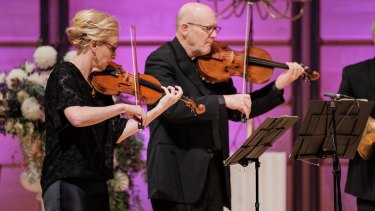By Peter McCallum
Sounds of Vienna. Australian Romantic & Classical Orchestra. City Recital Hall. June 16
★★★
Review by Peter McCallum
Joseph Eybler is best known to music history for working with the dying Mozart on the latter’s requiem but, when given the score to complete after Mozart’s death, being unable to do so. As documented by Otto Deutsch, however, Mozart said he was a “well-grounded composer equally skilled at chamber music and the church style”, and who are we to disagree.

Back for 2022: the Australian Romantic & Classical Orchestra.
This chamber music concert by members of the Australian Romantic & Classical Orchestra validated Mozart’s good opinion with a performance Eybler’s String Quintet in D major. Using instruments from the period, they adopted a tone that avoided bite and substance in favour of glassy, fluty lightness and a spirit of indulgent freedom and whimsical enjoyment.
This came alive most freshly in the finale, a concertante movement for the first violin, to which Jenna Sherry brought spirited brilliance and virtuosity. The Australian Romantic & Classical Orchestra aims to recreate the freedom of tempo and performance styles documented during the 19th century.
Eybler’s Quintet is of unknown date and of 18th-century style, but the approach was not out of place here. However, the string intonation began problematically and struggled to settle through the work, which marred the clarity of tone.
After interval, the six-string players (two violins, viola, cello and, unusually, double bass) were joined by clarinet (clarinetist and presenter Nicole van Bruggen), horn and bassoon for an all-too-rare performance of Schubert’s masterwork, the Octet in F major, D 803 from 1824.
With its slow introduction and six movements, including two in dance form, it has a comparable serenade-like structure to Eybler’s work. The sound at the opening had rewarding depth and definition and their unfettered approach to tempo was well apparent in the rush they gave to the rising phrase that starts the first allegro and the holding back on off-beat accents.
The slow movement had moments of stillness and communal concentration and they captured the mock military character finale themes with charm. Full enjoyment, however, was again marred by poor intonation which began well but deteriorated so that, for example, Schubert’s remarkable changes of key in the development section of the first movement lost their colour and luminosity.
A cultural guide to going out and loving your city. Sign up to our Culture Fix newsletter here.